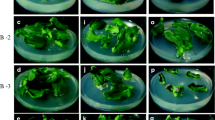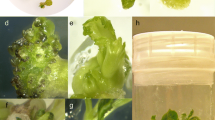Abstract
Camelina sativa was successfully established in vitro and systems for the regeneration of shoots from leaf explants developed. Methods for the surface-sterilisation of seeds were used which gave 95% germination, though the in vitro grown seedlings failed to develop beyond 28 days culture. In a micropropagation system, the rooting response of nodal explants was increased from a control level of 26.4% to 46.7% by the addition of 5.4 μM NAA. Leaf explants were more efficient for the regeneration of root and shoots than hypocotyls. For regeneration from leaf tissue the use of auxin (NAA) alone in the medium above a level of 0.54 μM resulted in root or callus growth. Cytokinin, in the form of BA alone failed to induce regeneration, but a combination of 4.44 μM BA and 0.54 μM NAA induced shoot regeneration at rates over 10.0 shoots per explant. Regenerated shoots were successfully transplanted to soil and flowered and set seed normally.
Similar content being viewed by others
References
Hansen LN (1997) Intertribal somatic hybridisation between Brassica oleracea L. and Camelina sativa. Crucifer. News 19: 55–56
Lovett JV & Duffield H (1981) Alleochemicals of Camelina sativa. J. Appl. Ecol. 18: 283–290
Millam S, Davidson D, Lanying Wen & Powell W (1991) A protocol for efficient tissue culture regeneration of rapid-cycling Brassicas. Biotechnol. Education. 2: 63–64
Millam S, Mitchell SM, Moscheni E & Lyon JE (1997) The establishment and regeneration of a range of Cuphea germplasm in vitro. Plant Cell Tiss. Org. Cult 48: 143–147
Moore M (1994) Camelina comes in from the cold. Furrow 99: 20–21
Murashige T & Skoog F (1962) A revised medium for rapid growth and bioassays with tobacco tissue cultures. Physiol. Plant. 14: 493–497
Narasimhulu SB, Kirti PB, Bhatt SR, Prakash S & Chopra VL (1994) Intergeneric protoplast fusion between Brassica carinata and Camelina sativa. Plant Cell Rep. 13: 657–660
Putman DH, Budin JT, Field LA & Breene WM (1993) Camelina: a promising low-input oilseed. In: Janick J & Simon J (eds) New Crops, Wiley (Chichester) (pp 314–322)
Schuster A & Friedt W (1995) Camelina sativa: Old face — new prospects. Crucifer. News. 17: 6–8 Zubr J (1997) Oil-seed crop: Camelina sativa. Industrial Crops and Products 6: 113–119
Zubr J (1997) Oil-seed crop: Camelina sativa. Industrial Crops and Products 6: 113–119
Author information
Authors and Affiliations
Rights and permissions
About this article
Cite this article
Tattersall, A., Millam, S. Establishment and in vitro regeneration studies of the potential oil crop species Camelina sativa. Plant Cell, Tissue and Organ Culture 55, 147–150 (1998). https://doi.org/10.1023/A:1006132407886
Issue Date:
DOI: https://doi.org/10.1023/A:1006132407886




